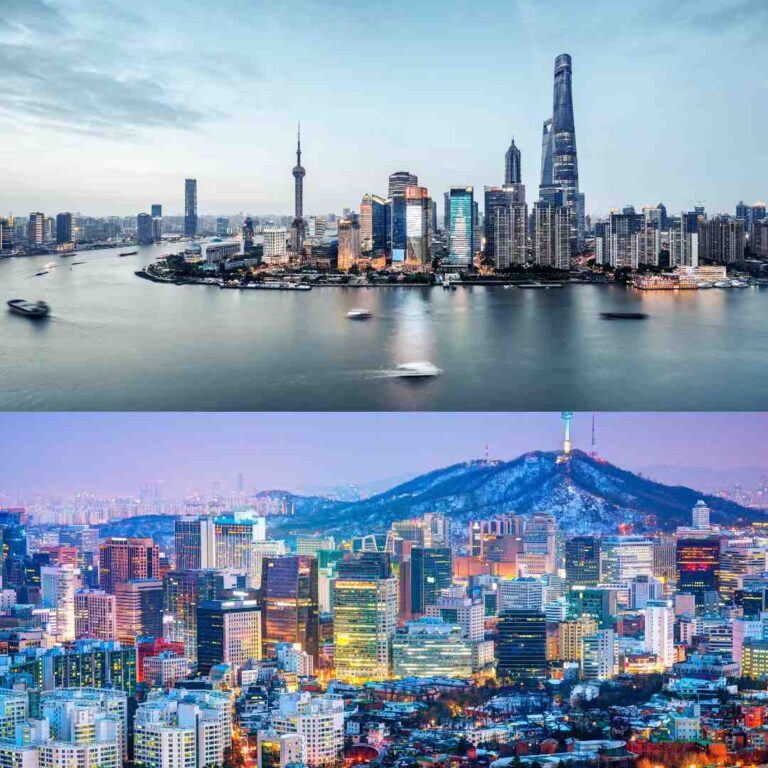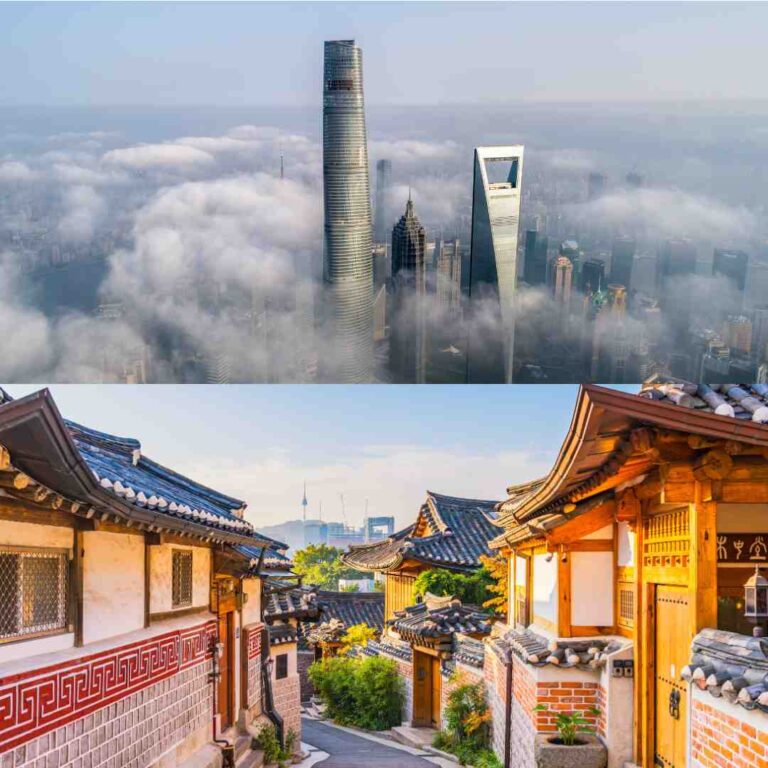When it comes to choosing a city for living, working, or just visiting, both Shanghai and Seoul stand out as vibrant, dynamic metropolises in Asia. Let’s delve into a detailed comparison of Seoul vs Shanghai across several key dimensions.

Employment Rate
Shanghai boasts a robust and diverse economy with significant opportunities in finance, manufacturing, and technology sectors. The city’s employment rate remains strong, driven by continuous growth and development.
Seoul, on the other hand, is a hub for technology, entertainment, and automotive industries. While both cities offer ample job opportunities, Seoul’s unemployment rate has historically been slightly lower, reflecting its strong domestic job market.
Luxury Living
Luxury living in both cities is exceptional but distinct.
Shanghai’s luxury scene is characterized by its opulent skyscrapers, high-end shopping districts like Nanjing Road, and a booming real estate market with luxury apartments overlooking the Huangpu River.
Seoul, meanwhile, offers a mix of traditional and modern luxury, with areas like Gangnam featuring exclusive boutiques, top-tier dining, and luxury residences. Both cities cater to affluent lifestyles but offer different cultural experiences.

Average Earnings
Average earnings in Shanghai have been on the rise, particularly in finance, technology, and international trade. However, the cost of living can offset these gains.
Seoul’s average earnings are competitive, especially in the tech and entertainment sectors. Despite high living costs in both cities, Seoul’s earnings often translate to a higher standard of living due to more affordable local goods and services.
Healthcare
Healthcare systems in both cities are world-class, but they operate differently. Shanghai has a mix of public and private hospitals, with increasing access to international-standard healthcare services.
Seoul is renowned for its efficient healthcare system, offering high-quality services at relatively lower costs, supported by a strong national health insurance scheme. Both cities attract medical tourists, but Seoul is particularly known for medical specialties like cosmetic surgery.
Urban Mobility and Transportation
Shanghai’s extensive metro system is one of the world’s largest, providing efficient connectivity across the city. The city also has a well-developed network of buses and taxis, though traffic congestion can be an issue.
Seoul’s public transportation system is equally impressive, known for its punctuality and cleanliness. With extensive subway lines and a comprehensive bus network, getting around Seoul is seamless. Additionally, Seoul’s use of technology in transportation, like T-money cards, enhances user convenience.
Seoul’s taxi is more expensive than that of Shanghai and traffic congestion is also an issue for Seoul. Calling taxi by Uber in Seoul and by Didi in Shanghai.

Housing and Accommodation
Housing in Shanghai varies from high-rise apartments to traditional lane houses, with significant price variation depending on the district. In recent years, housing prices have surged, making affordability a concern.
Seoul faces similar challenges with high demand in central areas leading to expensive real estate. However, both cities offer diverse accommodation options catering to different budgets, from luxurious apartments to more modest housing solutions.
Global Citizens and Expatriates
Shanghai is a melting pot of cultures with a large expatriate community drawn by its economic opportunities and vibrant lifestyle. International schools, cultural events, and expatriate clubs make it a welcoming city for foreigners.
Seoul, while slightly more homogeneous, has seen a growing number of expatriates, particularly from the US and other parts of Asia, attracted by its booming tech and entertainment sectors. Both cities are becoming increasingly cosmopolitan.
Population Dynamics
Shanghai, with a population of over 24 million, is one of the world’s most populous cities. Its rapid urbanization has led to a diverse demographic with a significant migrant population from other parts of China.
Seoul, with a population of around 10 million, is smaller but densely populated, with a highly educated workforce. Both cities are experiencing shifts towards more diverse, international populations.
Tourist Havens and Visitor Welcoming
Shanghai is a tourist magnet with attractions like The Bund, Yu Garden, and its futuristic skyline. The city is known for its hospitality and extensive tourist infrastructure.
Seoul also draws millions of visitors annually, fascinated by its historical palaces, vibrant nightlife, and K-pop culture. Both cities are extremely welcoming to tourists, offering a plethora of activities and sights.

Green Comparisons
Shanghai has been making strides in improving its environmental footprint, with initiatives to reduce air pollution and increase green spaces like Century Park. However, the city still faces significant environmental challenges.
Seoul is known for its green initiatives, including urban parks, rooftop gardens, and extensive recycling programs. The Cheonggyecheon Stream restoration is a notable example of Seoul’s commitment to creating a greener urban environment.
Concluding Insights: Seoul vs Shanghai
Both Shanghai and Seoul offer unique advantages and experiences, making them compelling choices for living, working, and visiting. While Shanghai excels in its economic opportunities and cosmopolitan lifestyle, Seoul stands out for its high quality of life, efficient public services, and cultural vibrancy.
Your choice between the two would depend on your personal preferences and priorities. Whether you are drawn to Shanghai’s dynamic growth or Seoul’s seamless blend of tradition and modernity, both cities promise an enriching and vibrant urban experience.
For anyone considering relocation or simply curious about these two incredible cities, this comparison provides a comprehensive look at what Seoul vs Shanghai have to offer, and both cities have much to explore and enjoy.
